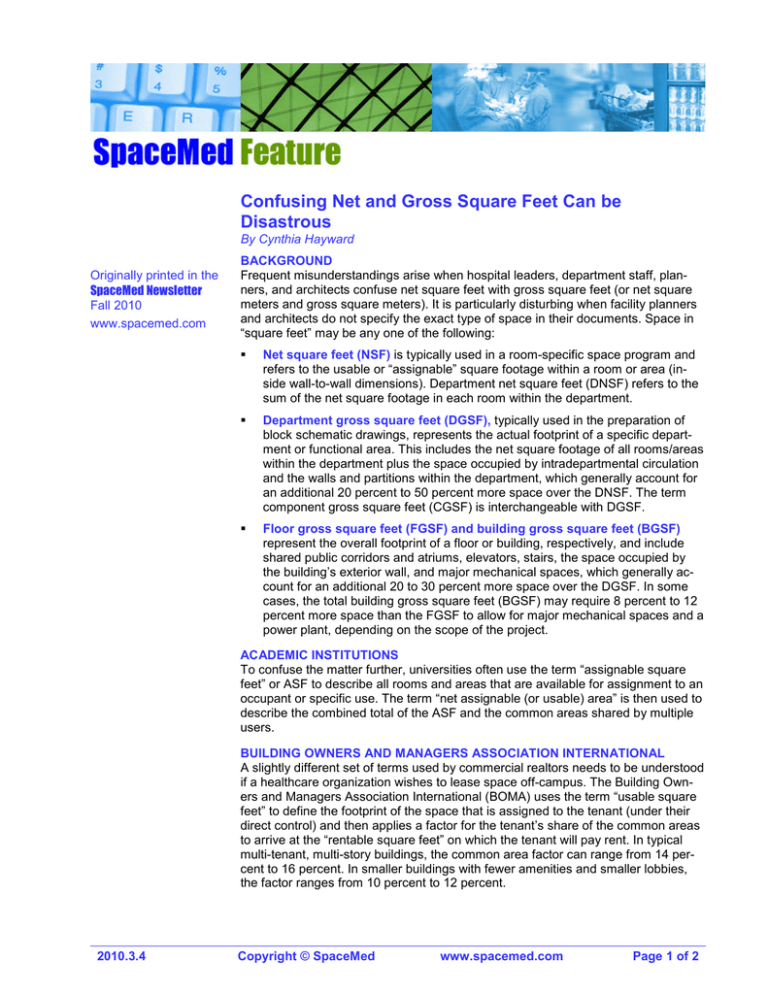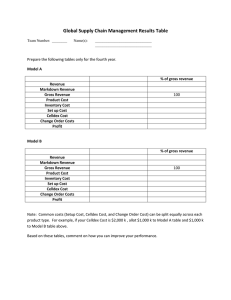Confusing Net and Gross Square Feet Can be Disastrous
advertisement

Confusing Net and Gross Square Feet Can be Disastrous By Cynthia Hayward Originally printed in the SpaceMed Newsletter Fall 2010 www.spacemed.com BACKGROUND Frequent misunderstandings arise when hospital leaders, department staff, planners, and architects confuse net square feet with gross square feet (or net square meters and gross square meters). It is particularly disturbing when facility planners and architects do not specify the exact type of space in their documents. Space in “square feet” may be any one of the following: Net square feet (NSF) is typically used in a room-specific space program and refers to the usable or “assignable” square footage within a room or area (inside wall-to-wall dimensions). Department net square feet (DNSF) refers to the sum of the net square footage in each room within the department. Department gross square feet (DGSF), typically used in the preparation of block schematic drawings, represents the actual footprint of a specific department or functional area. This includes the net square footage of all rooms/areas within the department plus the space occupied by intradepartmental circulation and the walls and partitions within the department, which generally account for an additional 20 percent to 50 percent more space over the DNSF. The term component gross square feet (CGSF) is interchangeable with DGSF. Floor gross square feet (FGSF) and building gross square feet (BGSF) represent the overall footprint of a floor or building, respectively, and include shared public corridors and atriums, elevators, stairs, the space occupied by the building’s exterior wall, and major mechanical spaces, which generally account for an additional 20 to 30 percent more space over the DGSF. In some cases, the total building gross square feet (BGSF) may require 8 percent to 12 percent more space than the FGSF to allow for major mechanical spaces and a power plant, depending on the scope of the project. ACADEMIC INSTITUTIONS To confuse the matter further, universities often use the term “assignable square feet” or ASF to describe all rooms and areas that are available for assignment to an occupant or specific use. The term “net assignable (or usable) area” is then used to describe the combined total of the ASF and the common areas shared by multiple users. BUILDING OWNERS AND MANAGERS ASSOCIATION INTERNATIONAL A slightly different set of terms used by commercial realtors needs to be understood if a healthcare organization wishes to lease space off-campus. The Building Owners and Managers Association International (BOMA) uses the term “usable square feet” to define the footprint of the space that is assigned to the tenant (under their direct control) and then applies a factor for the tenant’s share of the common areas to arrive at the “rentable square feet” on which the tenant will pay rent. In typical multi-tenant, multi-story buildings, the common area factor can range from 14 percent to 16 percent. In smaller buildings with fewer amenities and smaller lobbies, the factor ranges from 10 percent to 12 percent. 2010.3.4 Copyright © SpaceMed www.spacemed.com Page 1 of 2 Confusing Net and Gross Square Feet Can be Disastrous Continued COST ESTIMATING Defining exactly what is included in the “square feet’’ projection is critical in estimating construction costs. Department gross square feet are used in the preparation of renovation costs for individual departments. Floor gross square feet or building gross square feet are generally used in the preparation of predesign construction cost estimates for new construction or major renovation projects. CONCLUSION Misunderstandings among members of the planning team can be disastrous, because the DGSF is typically 20 percent to 50 percent higher than the DNSF. For example, confusing department net square feet with department gross square feet can deem certain facility configuration options feasible when they are not, or result in inaccurate early cost estimates. Physicians and clinical department managers may ask their peers at other institutions for comparative space information and receive “square feet” data with no indication of how it was calculated ― and then demand that their current space be expanded. Knowledge of how space allocation is calculated also eliminates surprises when leasing space off-site. On a final note, net and department gross square feet used for facility planning should not be confused with other methods of space measurement used by finance to account for charge-backs to individual departments, cost reimbursement, and asset tracking. Cynthia Hayward, AIA, is founder and principal of Hayward & Associates LLC. 2010.3.4 Copyright © SpaceMed www.spacemed.com Page 2 of 2
